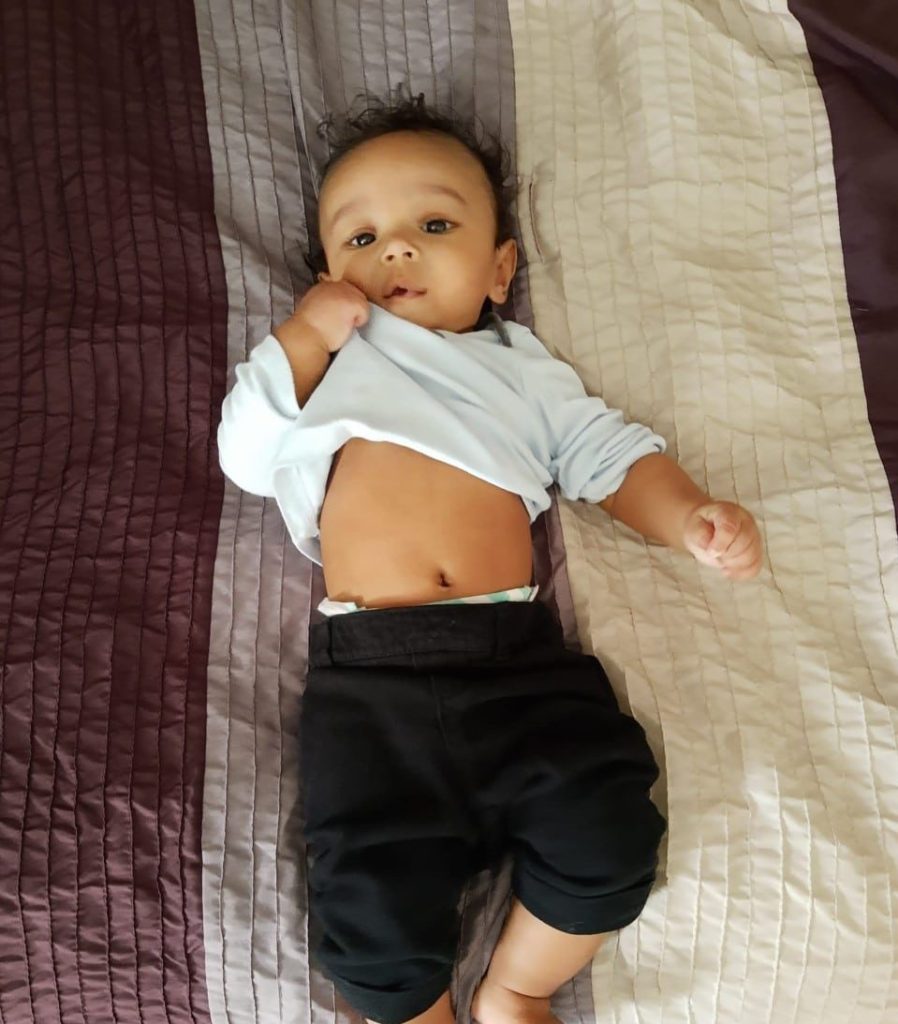I remember, as a new mom, wondering how on earth I was going to get my baby to sleep through the night. Jahan, my eldest, was a very bad sleeper and got well under the recommended infant sleep requirements. But, he was a very active and thriving boy. It was exhausting being up with him almost 24/7, so I invested in some courses and read up on what I could do to understand sleep training – how to get your child to sleep through the night
*When you click on links to various merchants on this site and make a purchase, this can result in this site earning a commission. Affiliate programs and affiliations include, but are not limited to, the eBay Partner Network. Please read my Privacy Policy for more information
There are so many different methods to use, and depending on your parenting style and what feels right to you, you will have a instinct on what works best for you. This blog posts discusses the cry it out method of sleep training, with frequent check ins, rather than prolonged crying. Some mom’s will not be comfortable with this so do what is right for you. I’ll give my tips on the topic of Sleep Training – How to get your child to sleep through the night
When to start sleep training
Always check with your pediatrician before starting any sleep training. They will be able to guide you based on your unique situation. The rule of thumb is generally once baby turns 6 months old, however, we started around the 7-8 month mark. For Jahan, due to his slower weight gain we were advised not to start sleep training at 6 months as he still needed the nighttime feeds. Once baby no longer needs those feeds, and has a pretty good temperament – isn’t colicky and doesn’t suffer from any health issues, you should be given the green light to start sleep training.
What methods can you choose from?
There are many different sleep training methods, each with it’s own set of pros and cons. Some mom’s will want to try the cry it out method while other’s will want to stay in the room with baby patting them. Other’s will prefer to co-sleep, or cuddle baby to sleep, then sneak away. The method you chose, will depend on your situation, your beliefs and your preferences.
Preparing for Sleep Training
Before you start sleep training, make sure you do the following:
- Discuss your plans with your pediatrician
- Ensure baby is sleeping safely in a crib and in their own room (more details on this later in this blog post)
- Have a baby monitor handy to watch baby during the process
- Prepare yourself mentally
- Ensure you understand the steps and place baby to sleep in the crib, on their back, awake (not sleeping or half sleeping)
- Go through your bedtime routine as you normally would (bath, massage, reading etc.) Just make sure baby is still awake when you put them down to sleep
- Be consistent and don’t give in or change the steps from day to day
The Cry it Out method – with some adjustments
The method I ended up using for both my children, was the Cry it Out method, with some adjustments. Some parents do the full out cry it out method, where they let baby cry themselves to sleep with no check in’s. Adding some adjustments, makes the process more comfortable as you check in and soothe baby during those check ins. When you do the check in’s, make sure you do not pat baby to sleep
Do not pick them up or rock them as that could become the expectation and will lead to rocking them to sleep. You know your child best, so if they are freaking out, throwing up from crying too much etc. pick them up and do what you need to do to calm them down. Just don’t make it a habit that you pick them up every time you check in on them. Only in circumstances where it is absolutely needed
Trust your instincts
If at anytime you don’t feel comfortable with this process, follow your instincts and do what is right for you. Sleep training is not for everyone
Make sure you purchase a baby monitor so you can watch baby and keep an eye on him or her. I have the one I recommend in my liketoknow.it profile, click here to take a look.
For this method, the steps are as follows:
- Night 1: Place baby in crib, stay with them a little bit and pat them. It’s important that you place baby in the crib, AWAKE. They should not be asleep, or half asleep. If you breastfeed your baby before bed, talk to them, or feed them with the lights on. Do what you can to make sure they stay awake. The whole point of sleep training is to teach baby to self soothe and learn to sleep on their own. Once you place baby in the crib and reassure them, wish them good night and leave
- Baby will cry. Keep an eye on them on the monitor. Go and check on them in a few minutes. How long you wait between intervals to do the check in is upto you and your comfort level. I waited around 2-3 minutes. It will be hard to hear baby cry, some will go all out and freak out. Step outside the house and keep the volume on the monitor down if it helps
- After the time interval you have set, go check on baby. Pat them, reassure them and let them know you are there and will come check on them. Wish them good night and leave
- Continue this way until baby falls asleep. It may be quicker then expected, or it may last an hour or so. You can increase the time intervals between each check in if you are comfortable doing so, or you can keep it consistent throughout. Be patient
- If baby wakes up in the middle of the night, follow the same process. Go in, check on them, reassure and pat them, then leave. It’s important to note that for each of these check ins, they should be brief and do NOT pat baby to sleep. It is important that they fall asleep on their own. This is the point of sleep training, teaching baby to self soothe and fall asleep on their own
- Morning Wake Up’s. Typically, baby’s are early risers. My rule of thumb was anytime after 5am, was acceptable in terms of a wake up time. If it was earlier than 5am, I would continue with the method outlined above. Some trainers will state you can continue to do the cry it out until 7am or a time you deem acceptable. It just didn’t work for us, baby wouldn’t sleep past 5am and would just cry
- Day 2-7: Continue using the same method outlined above and by the end of the day 7 mark, baby should be sleeping through the night. There will be the odd wake up here and there, continue to follow the steps above
Every day may be different from the last
There will be days that baby will fall asleep quick and easy. Other day’s will take longer. Some nights baby will sleep through the night, other times baby will wake up a few times. The key is consistency and continuing with the above process
What about regressions?
There will be days where it seems that baby is regressing. They take longer to fall asleep, they cry longer etc. This is part of the process, again be consistent and stick to the method
Consistency is key
It really is. The worst thing you can do, is change it up, or, pat baby to sleep, or give up and bring baby to bed. If you find it just isn’t working for you and it’s just too hard to hear baby cry and it doesn’t feel right to you then by all means, stop and try another method. But do that only if you plan to stop completely and not go back to the cry it out method. It isn’t doing baby good if you are inconsistent. If you pat them to sleep one night, or give up early and take them to your bed, then try to restart the process from scratch the next day, you are making the process harder for baby. They will be confused and will think if they keep crying eventually you will come and put them to sleep. That is the worst possible thing because baby will end up crying longer and harder thinking you will come back and put them to sleep. If you are consistent and stick to it, the crying will not last as long as baby will understand the process and go to sleep
To shop my recommendations on must have for mama’s, click on any of the pictures below, or check out my liketoknow.it profile
What about if baby gets sick and you need to stop sleep training?
There will be times when sleep training isn’t the way to go. If baby is sick, or teething, then helping baby to fall asleep via patting or rocking is acceptable. You don’t want to have baby cry it out when they are unwell
What about sleep training during travel?
Travel is typically another time when you can help baby sleep. With the time changes, difference in environment etc. having baby cry it out isn’t a good idea. Also, when you get home from vacation, those times will seem like a regression since they will expect you to put them to sleep. Sleep training should start again, once you are back home, after any time changes have been accounted for and baby is back to their normal sleep schedule
Baby should be sleeping in their own room and in a crib
Before you start sleep training, baby should be sleeping in their own room. If you have their crib in your room, beside you, it will be so much harder to sleep train. Imagine lying beside baby while they cry and ignoring them for the 2-3 minute interval. It just won’t work when they are looking right at you. Having them sleep in a crib is ideal, as bassinets typically aren’t safe once baby starts to roll anyways, and when baby is in their own room, transitioning to a crib is better
Set up the right sleep environment
Having black out blinds and a white noise machine and keeping the room temperature cool, will help baby sleep and set up a nice environment. Depending on when baby transitions out of their bassinet into a crib, and when they move into their room, they should be used to their new set up before sleep training should start. Give baby a few weeks to get used to being in their own room and in their new crib. You don’t want to start sleep training baby the same time they transition to their own room. It will be too much change for baby to handle all at once and will make the process that much harder
Sleep Training for Naps
When we started sleep training, we focused on the night time sleeps first. So we perfected the night time sleep training and once baby was comfortably sleeping through the night, we implemented the same method for naps, with some tweaks:
- One of the main differences between night sleep training and nap sleep training is the duration. With night time sleep training, you continue with the process until baby falls asleep. You use the same method consistently throughout the night for all wake up’s until morning wake up time. For naps, typically you give up after about an hour or so. So if baby hasn’t fallen asleep by the hour mark, take them out, and try again later
- Pick up on baby’s cues on when they are tired. Don’t wait until they are overtired to put them down for nap. Knowing their nap schedule and working within it are key
- When you are sleep training baby, make sure you are placing baby to sleep in their crib for the training. Don’t be changing up the schedule going out running errands, or having baby in baby carrier etc. The sleep environment should be exactly as it is for night time
- Once baby is officially sleep trained for naps, and has been for a few weeks, then you can take baby out and let them sleep on the go on occasion. Ie: if you are going out for grocery and baby sleeps in the car, or if baby sleeps in the stroller during a walk etc. that is okay once baby is sleep trained. But it should be avoided during the sleep training, training period
Practice Safe Sleeping Habits
Make sure you place baby to sleep on their back when you put them to sleep. I used a sleep sack on my boys for both their naps and night time sleeps. I didn’t use any pillows or blankets for their first year and found the sleep sack kept them warm. My go-to was the Halo sleep sack, linked here. I kept the room cool, and not too hot. Make sure the mattress on the crib is low if baby can stand up, to prevent them from climbing or falling out. Have a baby monitor to watch them and make sure they are okay especially during the times they cry. It will give you peace of mind
I hope this article helped provide tips on Sleep Training – how to get your child to sleep through the night. If you need tips on breastfeeding or formula feeding, check out my blog post, ‘Breastfeeding vs. Formula Feeding, which is right for you’? by clicking on this link. For tips on managing a high needs baby, please check out my blog post here





